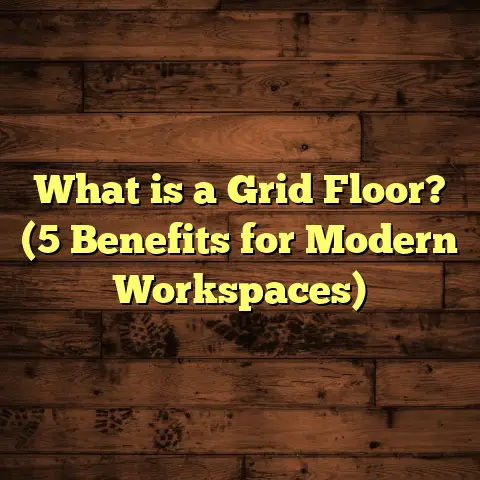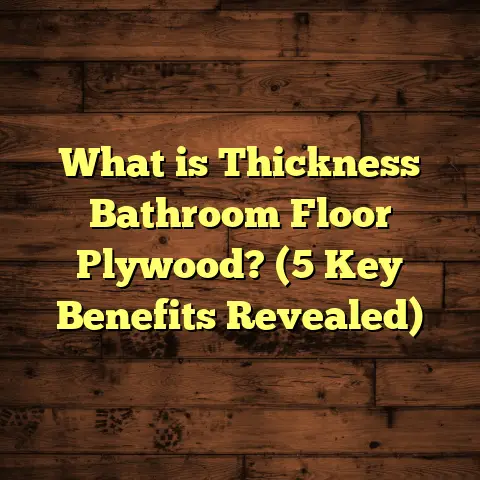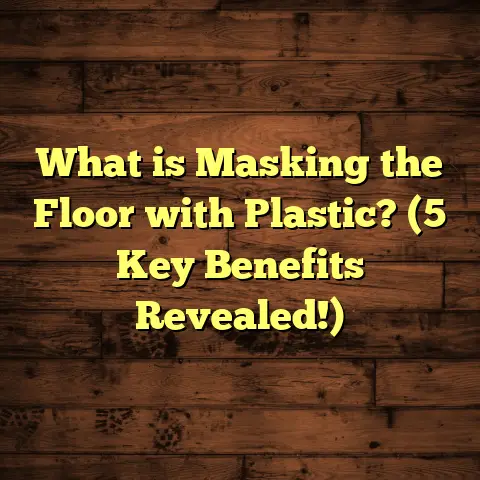What is Modern Terrazzo Floors? (5 Reasons to Love This Trendy Design)
Life moves fast, doesn’t it? Between juggling work deadlines, family commitments, and trying to squeeze in some personal time, the last thing I want to stress about is the floors underfoot. Yet when I decided it was time to renovate my home’s flooring, I found myself fascinated by something that seemed both classic and modern at the same time—modern terrazzo floors. You might have heard about terrazzo in passing or seen it in fancy hotels or airports, but it’s become a real trend in homes lately. If you’ve ever wondered, “What is modern terrazzo flooring? Why are people talking about it so much?” then this is for you. I’ll share what I learned, some personal stories, and even data that might nudge you toward considering terrazzo for your space.
What Is Modern Terrazzo Flooring?
Let’s start with the basics: what exactly is modern terrazzo flooring?
Terrazzo is a composite flooring material made by embedding small pieces of stone or glass—called aggregates—into a binder which is then polished smooth. This technique dates back centuries to Italy, where workers would use leftover marble chips to create durable, decorative surfaces. The name “terrazzo” actually means “terrace” in Italian because these floors were originally used in outdoor patios and walkways.
Classic terrazzo used a cement binder mixed with marble chips. Once dried, the surface was ground and polished to reveal a smooth, speckled finish.
Now, modern terrazzo has evolved in several ways:
- Epoxy Binders: Instead of cement, many terrazzo floors today use epoxy resin binders. These offer better flexibility, durability, and allow for a wider range of colors.
- Thin Applications: Epoxy-based terrazzo can be installed in thinner layers compared to traditional cement terrazzo which needs to be thicker and heavier.
- Customization: Modern terrazzo allows designers and homeowners to customize aggregate size, color combinations, and binder hues in ways not possible before.
In short, modern terrazzo is a highly adaptable flooring solution that combines timeless beauty with contemporary materials and techniques.
I first encountered terrazzo during a trip to a boutique hotel in downtown Chicago. The lobby floor caught my eye immediately—a stunning mosaic of white, gray, and black chips with hints of glass that shimmered subtly under the lights. It wasn’t just a floor; it felt like stepping onto a piece of art. That moment planted a seed, and I wanted to learn everything about terrazzo to see if it could work in my own home.
Why I Fell for Modern Terrazzo Floors: Five Reasons You Might Too
1. Durability That Keeps Up with Real Life
When you’re busy managing a household or running a business, durability isn’t just nice to have—it’s essential. Terrazzo floors are among the toughest flooring options out there.
Epoxy terrazzo floors are incredibly resistant to chipping, cracking, and wear. According to the Terrazzo Manufacturers Association (TMA), epoxy terrazzo floors can last anywhere from 40 to 75 years when properly maintained. That’s decades longer than hardwood floors (which usually last 20-30 years before refinishing) or laminate floors (often 10-15 years).
Here’s why terrazzo stands up so well:
- Seamless Surface: Unlike tile floors with grout lines that can crack or stain over time, terrazzo is poured or installed in large slabs with very few joints.
- Hard Surface: The aggregate chips embedded inside make it resistant to scratches and dents.
- Moisture Resistance: Epoxy binders repel water better than cement-based ones, making terrazzo suitable even for kitchens and bathrooms.
A school district case study I read showed that after 30 years of heavy daily use by hundreds of students walking and playing on epoxy terrazzo floors, the flooring required only minimal repairs and resealing every few years.
I can personally attest that after six months in my kitchen—which sees constant foot traffic from kids running around—the floor looks as good as the day it was installed.
2. Environmentally Friendly Flooring
I’m someone who tries to minimize my home’s environmental footprint whenever possible. One surprising discovery is how eco-friendly modern terrazzo can be.
Terrazzo often uses recycled materials as its aggregate chips. For example:
- Crushed recycled glass from bottles or windows
- Leftover marble or granite scraps from other construction projects
- Recycled quartz or other stone chips
The Environmental Protection Agency (EPA) supports using recycled materials to reduce landfill waste and conserve natural resources. Terrazzo fits perfectly into this principle by repurposing waste stone and glass.
Beyond the aggregates themselves, many epoxy binders used today have low volatile organic compound (VOC) emissions compared to older cement-based products. This means less harmful off-gassing during installation—a win for indoor air quality.
The National Tile Contractors Association highlights that terrazzo floors contribute points toward LEED green building certification because of their recycled content and durability (which reduces replacement waste).
In my own project, I sourced local recycled glass chips for the floor’s aggregates. Knowing my floor helped divert waste from landfills made me feel good every time I walked across it.
3. Design Flexibility That Fits Your Style
One of the best things about modern terrazzo is how customizable it is. If you think terrazzo only comes in dull gray or white, think again!
The size and color of the aggregate chips can be tailored exactly how you want them. Plus, the binder itself can be tinted any color—from bright reds to deep blues or anything in between.
You can get:
- Subtle neutrals for a minimalist look
- Bold pops of color for statement floors
- Large chunks of marble or glass for dramatic effect
- Geometric patterns using different colored sections
Because epoxy binders cure faster and offer more pigment options than cement, designers can experiment freely.
When I was choosing colors for my floor, I ordered several sample tiles with different chip sizes and color combos. It was fun to see how subtle changes changed the whole vibe of the room—from calm and classic to energetic and artsy.
If you have a creative streak or want your floor to reflect your personality uniquely, terrazzo lets you play with endless possibilities.
4. Low Maintenance for Busy People
Let’s face it: no one wants high-maintenance floors when life is busy. Terrazzo fits perfectly here because it’s easy to clean and maintain without special products or procedures.
You only need basic care:
- Sweep or vacuum regularly to remove dust and grit
- Mop with a neutral cleaner occasionally
- Reseal every few years depending on traffic (usually every 2–5 years)
Unlike hardwood floors that need refinishing or carpets that trap allergens, terrazzo resists stains and moisture well when sealed properly.
I’ve found that spending just 10 minutes twice a week sweeping and mopping keeps my floor shining beautifully without extra effort.
Plus, because it’s so durable, there’s no need for constant repairs or refinishing like some other materials require.
5. Adds Value and Makes a Statement
Besides being functional and beautiful, terrazzo floors make a strong style statement that can increase your home’s resale value.
According to a survey by the National Association of Realtors on home upgrades:
- Unique flooring options like terrazzo can add up to 5% increase in resale value.
- Buyers appreciate durable, low-maintenance surfaces.
- Stylish floors improve first impressions during showings.
When I showed friends photos of my new terrazzo floor, many were amazed—not just at how good it looked but by its timeless quality and smart investment appeal.
How FloorTally Helped Me Manage Costs and Budget
Now you might be asking yourself: “This sounds great—but what about costs? How do I figure out what this would cost me without getting overwhelmed?”
That’s where FloorTally came into play for me. It’s an online estimating tool designed specifically for flooring projects. It helped me get a realistic picture of installation costs early on without spending hours on phone calls or waiting for multiple quotes.
Here’s how FloorTally made my life easier:
- Accurate Local Estimates: The tool pulls labor rates and material costs based on your location so you get relevant numbers.
- Customizable Options: I could select different chip sizes, binder types (cement vs epoxy), and finishes to see how choices affected price.
- Waste Factor Included: It accounts for extra materials needed due to cutting waste which avoided surprises.
- Time Saver: All calculations happen in one place so no juggling spreadsheets or guessing.
- Budgeting Confidence: I used the estimates as anchors when discussing bids with contractors.
For instance, I learned that epoxy terrazzo installation cost around $30-$50 per square foot locally (including materials and labor), while cement-based terrazzo was slightly cheaper but took longer to install.
FloorTally gave me peace of mind that my project budget was realistic before signing contracts—a huge relief!
Diving Deeper: Technical Details About Modern Terrazzo Floors
If you like knowing what’s under the hood before making decisions like I do, here’s some more info about materials and installation processes for modern terrazzo.
Materials Breakdown
Aggregate Chips: These are the visible pieces that give terrazzo its character. Common materials include:
- Marble chips (classic choice)
- Crushed glass (adds sparkle)
- Quartz fragments (harder stones)
- Granite pieces (earthy look)
Chip size varies from tiny specks (1/8 inch) to large chunks (up to 1/2 inch). Larger chips create more visual texture but may cost slightly more.
Binder Types:
- Epoxy Resin: Flexible, durable, fast-curing, available in many colors. Most common today.
- Cement-Based: Traditional choice. Heavier and thicker application needed. Longer curing time.
- Polyester Resin: Less common now due to brittleness but sometimes used artistically.
Sealer: A final protective coating applied after polishing seals pores against dirt and moisture while enhancing shine. Usually a penetrating acrylic or urethane sealer.
Installation Process
- Subfloor Preparation: The surface must be clean, dry, smooth, and structurally sound. Any cracks or unevenness need repair.
- Divider Strips Installation: Metal strips are placed as dividers between color zones or sections.
- Mixing & Pouring: Aggregate chips are mixed into epoxy resin binder then poured onto subfloor.
- Spreading & Leveling: The mixture is leveled carefully using trowels.
- Curing: Epoxy sets within 24–48 hours; cement takes several days.
- Grinding & Polishing: Multiple passes with diamond grinding pads smooth surface revealing embedded chips.
- Sealing: Final sealer applied for protection.
- Buffing: Optional buffing step to enhance glossiness.
Installation Timeline
For an average kitchen-sized area (~200 sq ft):
- Epoxy terrazzo installation takes about 3–5 days including curing.
- Cement-based terrazzo can take up to 10–14 days due to longer drying times between layers.
More Stories From My Renovation Journey
I want to share some moments from my own experience that might help if you’re thinking about installing terrazzo yourself—or hiring pros.
Selecting Design Samples
Initially, I ordered samples from three different suppliers: one focused on purely white marble chips with gray epoxy; another had colorful recycled glass options; last was a mix of granite chips with earth tones.
I spread them out on my kitchen counter over several days just watching how light hit each one at different times of day; it was surprisingly addictive!
Eventually, I chose a subtle gray base with medium-sized white marble chips plus tiny bits of clear recycled glass for sparkle without overwhelming brightness.
Choosing Between Cement vs Epoxy Terrazzo
I debated whether traditional cement-based terrazzo might feel more authentic but realized the longer installation time and heavier thickness didn’t fit my timeline or budget well.
Epoxy resin offered more color options plus faster turnaround which suited my busy schedule perfectly.
Working With Contractors
Finding installers experienced with epoxy terrazzo took some searching online plus calls with local flooring companies.
One company impressed me because they sent me detailed portfolios showing past projects plus explained each step clearly—no jargon just straightforward answers.
During installation week, they checked in daily with photos so I could track progress remotely since I was working long hours away from home.
The Reveal
When they finally polished the floor after grinding and sealing—I was floored (no pun intended).
The surface gleamed like glass but had warmth thanks to natural stone chips embedded inside.
Friends who visited kept commenting on how unique yet timeless it looked—a rare combo in flooring!
What About Cost? Breaking It Down
Let me give you a clearer picture of what went into budgeting my terrazzo floor project so you can gauge what you might expect:
| Cost Component | Price Range (USD) | Notes |
|---|---|---|
| Materials (epoxy + aggregates) | $10 – $20 / sq ft | Depends on chip size & type |
| Labor (installation + polishing) | $20 – $30 / sq ft | Skilled labor needed |
| Sealer & finishing products | $2 – $4 / sq ft | Usually bundled |
| Waste factor & extras | ~5% additional | Accounted in FloorTally |
Total estimated cost per square foot was about $32-$50 depending on choices and location.
Compared to hardwood ($6-$12 per sq ft) or luxury vinyl ($3-$7), terrazzo is more upfront investment but lasts much longer—making it cost-effective over many years.
FloorTally helped me model these costs by inputting variables like square footage and material preferences which saved trial-and-error guesswork.
Comparing Terrazzo With Other Popular Flooring Options
If you’re thinking about your next floor project, how does terrazzo stack up against other common types?
| Flooring Type | Durability | Maintenance | Cost Per Sq Ft | Style Options | Installation Time |
|---|---|---|---|---|---|
| Epoxy Terrazzo | Excellent (40+ years) | Low (simple cleaning) | $30-$50 | Very high | 3-5 days |
| Hardwood Floors | Good (20-30 years) | Medium (refinishing needed) | $6-$12 | High | 1 week+ |
| Laminate Floors | Moderate (10-15 years) | Low | $3-$7 | Medium | 1-3 days |
| Ceramic Tile | Excellent | Medium (grout cleaning) | $5-$15 | High | 2-4 days |
| Carpet | Low (5-10 years) | High (vacuuming/stain removal) | $2-$5 | Medium-low | 1 day |
Terrazzo stands out mainly due to its durability paired with unique aesthetics and relatively low upkeep once installed well.
What Kind of Rooms Are Best for Terrazzo?
Terrazzo works well in many areas but here are some favorites based on performance:
Kitchens
Because terrazzo resists moisture and stains especially when sealed right—it’s perfect for kitchens where spills happen daily.
Bathrooms
Epoxy terrazzo resists water damage better than cement versions making it great in bathrooms too.
Entryways & Hallways
High foot traffic zones benefit most from durable surfaces like terrazzo which won’t wear down quickly.
Living Rooms & Open Areas
With so many design options available—you can create stunning centerpiece floors that impress visitors immediately.
Tips If You’re Thinking About Installing Terrazzo Floors
If you’re sold on trying terrazzo but want some pointers from my experience:
- Order Samples Early: Seeing colors/chip sizes in your lighting helps avoid surprises.
- Check Installer Experience: Ask for portfolios; epoxy terrazzo needs skilled hands.
- Plan Your Timeline: Epoxy cures faster but still requires a few days downtime.
- Budget Wisely: Include waste factor; use tools like FloorTally for estimates.
- Maintenance Routine: Invest in quality sealer; regular sweeping/mopping keeps floors beautiful.
- Consider Underfloor Heating: Terrazzo pairs wonderfully with radiant heat due to its thermal conductivity.
- Protect During Renovations: Avoid heavy dropped objects during installation phase as epoxy is tough but not indestructible before curing.
Final Thoughts From My Journey With Terrazzo
I never imagined that choosing flooring would become such an interesting adventure! From discovering what modern terrazzo really is, exploring design options, working through budgeting challenges with FloorTally’s help, all the way through installation day—it has been rewarding beyond just aesthetics.
My floors now carry stories—of craftsmanship, sustainability choices I’m proud of, and a smart investment that will stay with my home for decades.
If you’ve been curious about terrazzo or want something durable yet stylish that fits into your busy life seamlessly—give it serious thought. Sometimes the right floor isn’t just beneath your feet—it can be the foundation of your home’s character too.
If you want me to help you find installers nearby or guide you through design ideas tailored for your space—just ask! Happy flooring adventures ahead!





